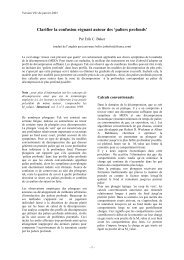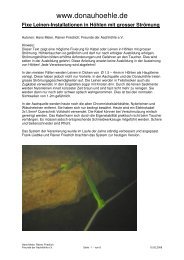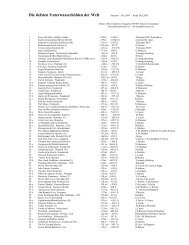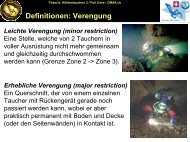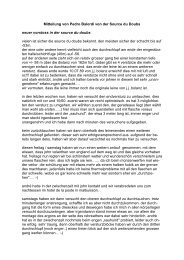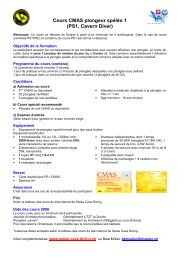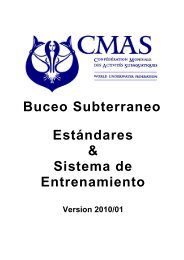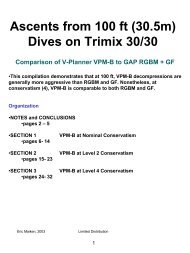cave diving and the nss - bei Swiss-Cave-Diving
cave diving and the nss - bei Swiss-Cave-Diving
cave diving and the nss - bei Swiss-Cave-Diving
Create successful ePaper yourself
Turn your PDF publications into a flip-book with our unique Google optimized e-Paper software.
46 CAVE DIVING COMMUNICATIONS<br />
Five-line intersection<br />
This drawing depicts a line intersection similar to ones seen by <strong>the</strong><br />
authors in some of <strong>the</strong> maze-like <strong>cave</strong>s in <strong>the</strong> Bahamas. The<br />
information presented by <strong>the</strong> arrows suggests that <strong>the</strong> doublearrowed<br />
line is <strong>the</strong> recommended route out of <strong>the</strong> <strong>cave</strong>. There may<br />
be locations which require that <strong>the</strong> guideline be so completely<br />
identified, but this added indentification may also create more<br />
confusion in low visibility than it cures.<br />
REELS AND LINE MARKERS 47<br />
Reels<br />
THE PRIMARY REEL<br />
For <strong>cave</strong> divers who are visiting a <strong>cave</strong> where <strong>the</strong>y do not<br />
expect to lay new survey line of <strong>the</strong>ir own, <strong>the</strong> primary reel serves<br />
to establish a continuous guideline from <strong>the</strong> entrance to <strong>the</strong> permanently<br />
installed line in <strong>the</strong> <strong>cave</strong>. In most locations, particularly<br />
North Florida, <strong>the</strong> permanent line begins in far enough so that you<br />
must lay line to it. The method of tying onto this guideline with <strong>the</strong><br />
primary reel, beyond certain m<strong>and</strong>atory requirements, is a matter<br />
of personal choice.<br />
However, for consistency, we are recommending <strong>the</strong> following<br />
procedure: Wrap <strong>the</strong> primary reel line twice around <strong>the</strong> permanent<br />
guideline, <strong>the</strong>n clip <strong>the</strong> reel onto <strong>the</strong> permanent line<br />
in <strong>the</strong> direction of travel. Clipping <strong>the</strong> reel onto <strong>the</strong> guideline in<br />
<strong>the</strong> direction of travel is arbitrary, but it does establish a practice<br />
which will be consistent with those that follow. Mounting <strong>the</strong> reel<br />
in this manner also places <strong>the</strong> reel in a very convenient position for<br />
retrieval during <strong>the</strong> exit. Everything is in <strong>the</strong> right place for easy<br />
pick up at <strong>the</strong> right moment. There is a minimum of fumbling to<br />
disengage <strong>the</strong> lines. For <strong>the</strong> same reason it is also wise to avoid<br />
connecting temporary <strong>and</strong> permanent lines toge<strong>the</strong>r at <strong>the</strong> same<br />
tie-off point. Moving <strong>the</strong> primary reel away from this spot a few<br />
inches will greatly ease disengagement.<br />
Clo<strong>the</strong>spin added to OUTBOUND side of line to<br />
reconfirm directional information at a line jump<br />
Typical primaryreel<br />
tie-off onto<br />
permanently installed line<br />
At tie-off point, <strong>the</strong> primary reel is wrapped<br />
twice around <strong>the</strong> permanent line. Excess<br />
line is stowed on <strong>the</strong> primary reel; <strong>the</strong><br />
reel is locked off <strong>and</strong> clipped onto <strong>the</strong> permanent<br />
line in <strong>the</strong> direction <strong>the</strong> team is swimming.




